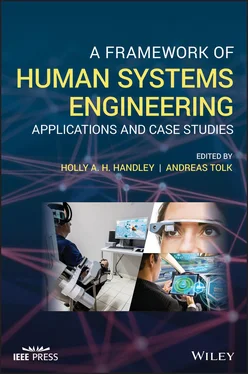A Framework of Human Systems Engineering
Здесь есть возможность читать онлайн «A Framework of Human Systems Engineering» — ознакомительный отрывок электронной книги совершенно бесплатно, а после прочтения отрывка купить полную версию. В некоторых случаях можно слушать аудио, скачать через торрент в формате fb2 и присутствует краткое содержание. Жанр: unrecognised, на английском языке. Описание произведения, (предисловие) а так же отзывы посетителей доступны на портале библиотеки ЛибКат.
- Название:A Framework of Human Systems Engineering
- Автор:
- Жанр:
- Год:неизвестен
- ISBN:нет данных
- Рейтинг книги:4 / 5. Голосов: 1
-
Избранное:Добавить в избранное
- Отзывы:
-
Ваша оценка:
- 80
- 1
- 2
- 3
- 4
- 5
A Framework of Human Systems Engineering: краткое содержание, описание и аннотация
Предлагаем к чтению аннотацию, описание, краткое содержание или предисловие (зависит от того, что написал сам автор книги «A Framework of Human Systems Engineering»). Если вы не нашли необходимую информацию о книге — напишите в комментариях, мы постараемся отыскать её.
A Framework of Human Systems Engineering
Applications and Case Studies
A Framework of Human Systems Engineering: Applications and Case Studies
A Framework of Human Systems Engineering — читать онлайн ознакомительный отрывок
Ниже представлен текст книги, разбитый по страницам. Система сохранения места последней прочитанной страницы, позволяет с удобством читать онлайн бесплатно книгу «A Framework of Human Systems Engineering», без необходимости каждый раз заново искать на чём Вы остановились. Поставьте закладку, и сможете в любой момент перейти на страницу, на которой закончили чтение.
Интервал:
Закладка:
Emerging developments in the technology platforms of sensors, data, artificial intelligence (AI), computer vision, and mobile devices are enabling advancements in the SA platforms that provide real‐time decision‐making opportunities in both structured and unstructured space. These developments challenge the traditional ways that information has been collected, aggregated, collated, analyzed, disseminated, and provide opportunities to empower operators and citizens to gain greater awareness of their surroundings in order to make better informed and more meaningful decisions. Inherent challenges with the volume, variety, velocity, and veracity of this information demand novel approaches to HSI across multiple, concurrent operational theaters.
This chapter summarizes major considerations given to SA platforms and illustrates these through their application to the public safety domain. The authors draw on their decades‐long experience designing and implementing SA systems in municipal and federal public safety organizations in regions as diverse as the United States, Middle East, and Africa. Due consideration is given to the growing concerns around privacy in Western nations and the apparent paradox around the need to promote transparency within public safety organizations without empowering terrorists, criminals, and others' intent on disrupting the lives and liberties of those engaged in democratic societies.
2.2 Situational Awareness: A Global Challenge
Situational awareness is a concept, a system, and a solution. There are well‐established SA definitions and related organizations for the maritime domain, the space domain, and the Arctic. In her seminal Designing for Situation Awareness (Endsley 2011), Dr. Mica Endsley summarizes SA as “being aware of what is happening around you and understanding what that information means to you now and in the future.” Elsewhere, Dr. Endsley has defined SA as “the perception of the elements in the environment within a volume of time and space, the comprehension of their meaning, and the projection of their status in the near future.” 1 It is the internal mental model of the dynamic environment, which when combined with more static system and procedural knowledge allows decision makers in these domains to function effectively.
In the wake of the 9/11 attacks, the New York Police Department (NYPD) led a public–private partnership (PPP) effort to create what became the Domain Awareness System (DAS) to counter future terrorist attempts and to improve public safety. 2 This initial DAS effort by the NYPD provided a subsequent technology framework for the development of real‐time SA solutions to address a broad range of public and private use cases, from high value facility security and border management to conflict zone and environmental protection, to healthcare, to opioid crisis response, and to the recovery of persons at risk from human traffickers. In each of these use cases, development was led by industry in partnership with government.
The Chinese central government has led PPP development of its “Sharp Eyes” surveillance system. 3 By intertwining digital commerce with public safety, China has created an unprecedented surveillance apparatus with near limitless opportunities for machine learning and analytics to process, categorize, and contextualize information for human operators. This surveillance system model now exported around the world as “Safe City” solutions challenges the Western notion of privacy and human rights when employed against targeted population groups like the Muslim Uighurs in western China.
In light of this range of applications, the definition of “situational awareness” remains somewhat ambiguous and nonpractical. For the purpose of this paper, SA refers back to the foundational definition espoused by Dr. Endsley and refers to the real‐time presentation of pertinent information to a human operator to inform subsequent action. The geographic domain is relevant only in so much as its relevance to the human operator in question. Similarly, historic information and trends are relevant only in as much as they apply to the real‐time context of the operator. Multiple operators may be involved in a single event, and the SA platform must consider the perspective and context of each in order to achieve its intended purpose.
2.3 Putting Situational Awareness in Context: First Responders
Although much literature has been written on SA concepts in the aerospace, military, and maritime domains, the proliferation of Internet of Things (IoT) devices and advancements in machine vision and AI have enabled the democratization of SA capabilities. Under the banner of “smart cities,” municipalities have begun implementing static surveillance capabilities and outfitting first responders with mobile and body‐worn devices that act as both a sensor and a means of improving SA. By some estimates, the market for surveillance equipment will reach $77B by 2023. 4 This explosion in sensors has led to increased public safety expectations, as well as greater scrutiny over the actions taken by first responders.
To meet these expectations, law enforcement agencies in particular employ a variety of surveillance tools to achieve awareness of events occurring in the geographic domain under their authority. These tools include closed‐circuit television (CCTV) cameras; license plate readers; and chemical, biological, radiation, nuclear, and explosive (CBRNE) sensors. Historically compartmented information warehouses containing criminal histories, emergency calls, use of force logs, and similar are increasingly being fused and made available for real‐time search. Moreover, noncriminal information ranging from social media and other open‐source datasets to credit histories and other quasi‐public records are increasingly accessible to provide context to an event. The use of such noncriminal records to assist law enforcement is often vigorously contested and will be addressed later in this chapter, but regardless of a particular agency's implementation, today's challenge remains a big data problem. In other words, identifying the particular set of information relevant to an event is paramount; with few exceptions, the requisite data points to improve an officer's SA are available.
Complicating the analysis and dissemination of pertinent information to SA are the layers of information security policies applied to the first responder community. For example, law enforcement agencies in the United States must adhere to the Criminal Justice Information Standards established by the Federal Bureau of Investigation. 5 These standards mandate, among other requirements, that anyone accessing law enforcement data first authenticate themselves as a qualified operator and further establish a need to know the information requested. These regulations are often further restricted by agency‐specific policies, such as preventing the disclosure of information pertaining to active cases to anyone not specifically associated with the case in question. Such policies and regulations were generally enacted and expanded in the wake of inadvertent (or deliberate) misuse of information over many decades. Few contemplated the ramifications on nonhuman actors, such as the potential of AI, and fewer still considered how persistent access to such information may contribute to real‐time SA platforms charged with improving the safety and effectiveness of modern‐day first responders.
It is in this context that the demands on first responders to employ SA platforms for decision support are being placed. With this comes a myriad of HSI concerns, ranging from the physical real estate available to first responders to interact with SA platforms to the means by which this complex set of information can be presented. Underpinning all considerations is the paramount importance of officer safety and the need to understand the operator's context in order to establish information relevance and right to know.
Читать дальшеИнтервал:
Закладка:
Похожие книги на «A Framework of Human Systems Engineering»
Представляем Вашему вниманию похожие книги на «A Framework of Human Systems Engineering» списком для выбора. Мы отобрали схожую по названию и смыслу литературу в надежде предоставить читателям больше вариантов отыскать новые, интересные, ещё непрочитанные произведения.
Обсуждение, отзывы о книге «A Framework of Human Systems Engineering» и просто собственные мнения читателей. Оставьте ваши комментарии, напишите, что Вы думаете о произведении, его смысле или главных героях. Укажите что конкретно понравилось, а что нет, и почему Вы так считаете.












